One wedding, several koras and a very long way - Part 1: Kashgar to Lake Manasarovar
The journey was really a long way - physically, mentally and emotionally. A solid work out for the body/mind! But while outer muscles recover easily, inner ones can take a little longer. I won't bullshit or gloss over stuff in this posting, i intend to be more emotionally real and reflective. The journey, particularly within the TAR - Chinese occupied Tibet - was tough. I saw more negativities emerge from this mind than i have in a long while and this was both highly uncomfortable and very humbling. Mostly it was in relation to the "Chinese" and my judgmental interpretations of them and their behaviour; my struggle and mostly failure to find compassion and a space of deeper understanding of 'them'. The emotionally immature part of myself is wanting to divide and separate and make them 'bad', 'wrong' and semi-beastial. Exactly the same technique that political leaders use when they want to convince one nation to go to war on another. The slightly more sane part of me wants to see straight through that and go way, way beyond it. Little steps huh,......
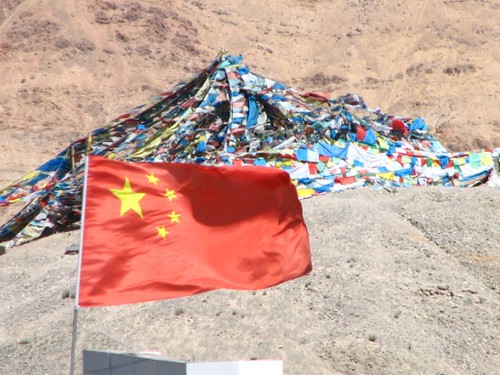 Prayer flags behind the red curtain,....
Prayer flags behind the red curtain,....
As a group of four very individual individuals undertaking an arduous physical and mental pilgrimage together, i can only say i feel blessed and honoured to have had such companions for the trail. We were each tested in different ways and saw some of the best and worst in ourselves and each other and provided space, support and understanding when required. Our parting after the first Kora around Mt Kailash (Mark moving on to other areas of Tibet) was relaxed and felt like a natural conclusion to a wholesome shared experience. Looking forward to catching up with Mark and Joe here in Kathmandu and seeing what else they got up to in Tibet!
So,....stories, stories and pictures. Where were we up to?? Somewhere around Kashgar i recall, hoping to find an accomodating illegal mode of transport across 1500km of dry, high mountains into the TAR,......
We scored a local bus from Kashgar to Yechen - the jumping off point for illegal transport into the western TAR and to Ali, its administrative centre. It was only about 6 hrs, but across an incredibly dry desert pavement landscape, flat and barren all the way to a haze-stained horizon. Dancing dust-devils swirly-whirling up out of the void, spiraling dust upward in a frenzied vortex of grit and energy before disintegrating back into nothing. We were all mutually groaning our lack of appreciation when the VCD player on the bus went on for a second round of the same C-grade Chinese music videos. I spotted a potential source of audio relief - a couple of exposed speaker wires! At the next stop, a deft hand movement and a couple of speaker wires were twisted together in a neat short circuit, thus sending the two offensively squawking speakers nearest us into the bardo-bliss of sweet silence. How clear and light we were after this! (apologies to non-Buddhists for unintelligible jokes!).
Yechen was a dusty, dead-end truckstop mostly, full of Han Chinese very far from home and the indigenous Uigyuir people, mostly avoiding eachother. Interesting. I am sure it would make a fascinating social study. The straight, lonely and very wide main street had a large Peoples Liberation Army base on one side and brothel after brothel after brothel on the other side - lit up inside with pink neon, signs hanging above the doors with smiling, 1/2 naked, pubescent Chinese girls.
Prostitution seems very much out in the open there and i guess the PLA base provides an ample supply of testosterone charged customers. When we first rocked up during the afternoon (before the pink lights went on) Mark and i were searching for accomodation and accidentally wandered into one thinking it might be a hotel. They seemed very smiley and happy to have us in there (which sent alarm bells ringing!) and then quickly ushered Mark upstairs to look at a 'room' while i stayed downstairs and tried to decipher the large board listing prices next to 'services'. We left rather quickly.
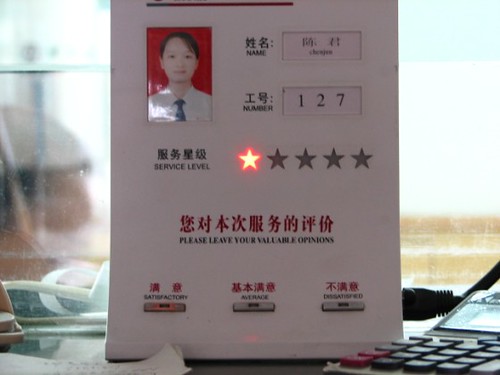 Notions of efficiency. Is number 127 'satisfactory', 'average' or are you having a bad hair day and feel like pushing 'dissatisfied'?
Notions of efficiency. Is number 127 'satisfactory', 'average' or are you having a bad hair day and feel like pushing 'dissatisfied'?
Expecting that we were going to have to split into two groups in order to hitch a lift in a truck to Ali, we were very sweetly surprised to discover a sleeper bus willing to take us directly there in a couple of nights time. Amazing! Too easy. Apparently the guy had some police contacts and said it was no problem, normal even. Quite different to the stories we had heard from fellow travellers who did this journey last year. Seems as though things are opening up along this route - for the moment at least. So, we organised a joint day of meditation in our little 4 bed dorm, silence and inward looking a more sane way to spend our time than than pacing up and down a dusty, divided street.
At the appointed hour, we rocked up to get on the awaiting bus and were told to hide in a back room for one hour to avoid any nosey police that might be lurking about. During this time the window seats near the front of the bus - which we had requested when purchasing tickets and had been assured of - were occupied by immovable, chain-smoking Chinese passengers. Injies (Tibetan for 'westerners') had for dinner again! Bundled up in the reclining position we disappeared into a darkening night in the wake of a wild and blustery duststorm. Bound for Tibet,......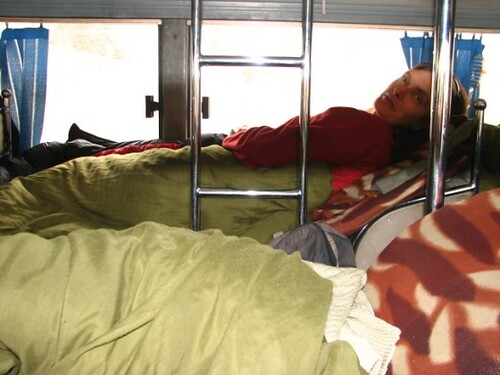 The sleeper bus-rattle blues,....
The sleeper bus-rattle blues,....
At about 2am we were awoken to go into an army checkpost. Nerve throttle open, a little unsure what would happen next. Wide eyed. Chinese being scrutinised and names written in a ledger. Our passports were diligently checked, but no details were recorded in the book. Ahhhh, so the army checkpoint fellas are in the bus companies baksheesh loop and us injies allowed to slip by the back way. We were not here; I did not see you; or just like Manuel from Fawlty Towers "I know nuh-ting!". Back on the juddering bus, rolling along the hours of a harsh and wild landscape outside the windows. The Aksai Chin is an elemental place. Few nomads even venture there, there is so little grass and water.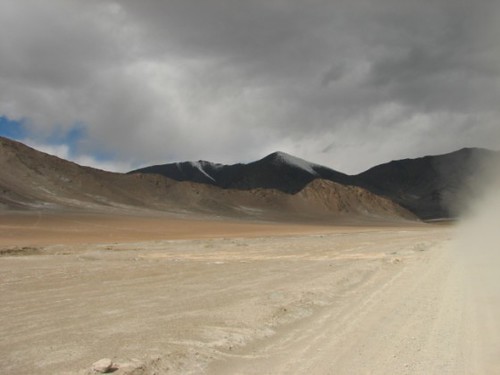 Juddering along the Aksai Chin
Juddering along the Aksai Chin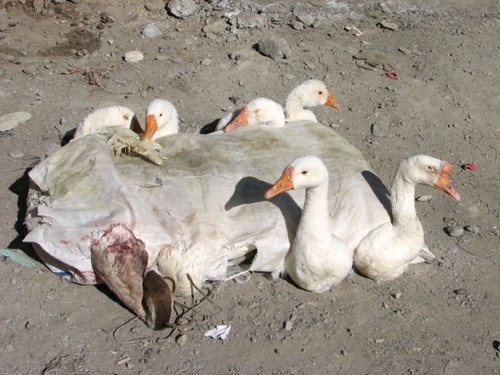 Little duckies bagged for the frying pan
Little duckies bagged for the frying pan
At a roadside truckstop i see yet another example of human disconnection and contempt for other sentient beings. Eight geese stuffed into a bag, trucked in for the restaurant trade, waiting for the pot, frying in the sun without food or water. One was dead, another injured and close to death. What to do? Such treatment is so unnessesary.
At around 6pm that evening, almost 24 hours into the trip, we encountered an interesting situation. Our bus driver tried crossing a deep stream a tad too fast. This caused the radiator fan to explode into high speed razor-shards (due to hitting the water or a rock?) thus tearing great gashes in the radiator cooling fins. I watched the divers assistant try to fill up the radiator after we stopped to assess the extent of the leakage - it poured out almost as fast as he poured it in!
The interestingness of this situation had a sharp edge to it. We were on the verge of the highest pass on the Aksai Chin road, at about 5000m. We were feeling the altitude, but doing fine, due in part to our previous acclimatisation efforts, plus Anna, Mark and I were rolling on Diamox as well (a useful drug for altitude that helps the kidneys restore blood pH which gets out of whack due to CO2 / O2 imbalances - you have to drink and piss like a trojan though!). However, some of the Chinese on the bus were doing decidedly less well. One woman had been vomiting repeatedly for several hours and a couple of others were snorting oxygen and the guy next to me had been rolling around groaning, holding his head and was now either asleep or unconsious, i couldn't tell.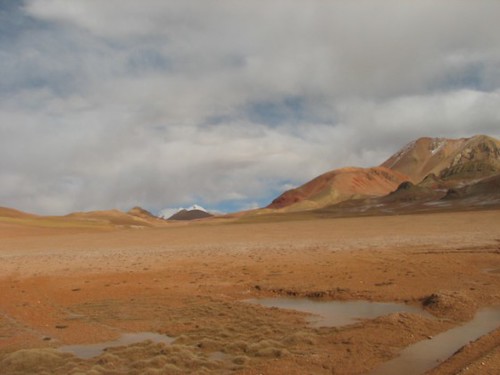 Red-earth and vast open spaces on the Aksai Chin
Red-earth and vast open spaces on the Aksai Chin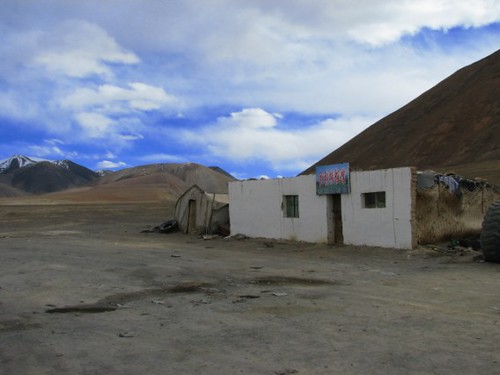 High altitude truck stop on the Aksai Chin, site of our impromptu radiator repairs
High altitude truck stop on the Aksai Chin, site of our impromptu radiator repairs
We eventually limped back to a truck stop that was only several km from the site of our drivers over-zealous river crossing attempt. We bundled off the bus while they started the task of pulling out the entire radiator for a full-on roadside repair jobbie on the restaurant floor. We were here for a while so we settled in. During dinner the front door of the warm restaurant we had all retreated into swung open - some other passengers virtually dragged into the room the Chinese woman who had been vomiting. She was now in a barely conscious state.
This was a tricky situation. She was in a really bad way and had deteriorated rapidly since stopping at this altitude. We knew enough about Acute Mountain Sickness, its symptoms and treatment to know that this woman was in a potentially life threatening condition. Death from HACE (high altitude cerebal odoema - swelling around the brain) can occur in as little as six hours of manifesting severe symptoms and we had been here for 3-4 hrs already. The Chinese seemed to know bugger all and took a bit to comprehend the seriousness of her situation whilst Anna and i checked her out.
She had all the classic symptoms; very rapid, but faint pulse; massively dilated pupils; severe headache; persistant vomiting; she was only just conscious and failed miserably a gait-ataxia test (straight line walk toe-to-toe). She couldn't walk without assistance on both sides and even then still dragged her feet. If one was trekking in Nepal this would mean down, down, down - NOW!!! - regardless, even if it was the middle of the night and bucketing rain, as the person could be dead by morning. We communicated this, but there were no cars or trucks working at this place to take her down and the radiator repair job underway was of unknown duration and uncertain outcome. What to do?
We had some strong steroid medication, precisely for this kind of situation, which can temporarily reduce HACE related brain swelling and buy the patient some time in which to get down. Dishing stuff like that out to one of us four would be one thing - our lives and our risk - but to dish it up to a stranger, not knowing if they might react or ???, was a bit freaky to say the least. Given the circumstances there was little choice. We gave her the pills to pop, kept a close eye on her and prayed the radiator was fixed soon. Her husband ignored our advice and gave her some food after the pills, so she threw up again 40 mins after taking them. How much had she adsorbed into her bloodstream? Do we give her more? Her pulse had grown stronger after the meds and she was more alert, but other symptoms still remained. Anyway, we kept a close eye on her and to cut a long story short, the radiator was fixed by about 1am in the morning and we rumbled off into the darkness and over the pass and down, down, down - only 800m lower, but that was enough to reduce her acute symptoms. So, our Chinese lady-friend made it to Ali (with a sore head, but in one piece!) and so did we, 40 bone-jarring and Chinese-ciggarette-smoke filled hours later.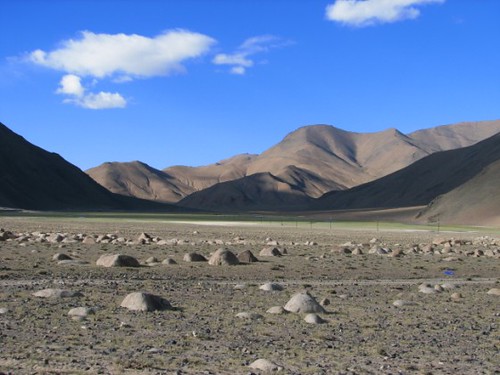 First views in Tibet
First views in Tibet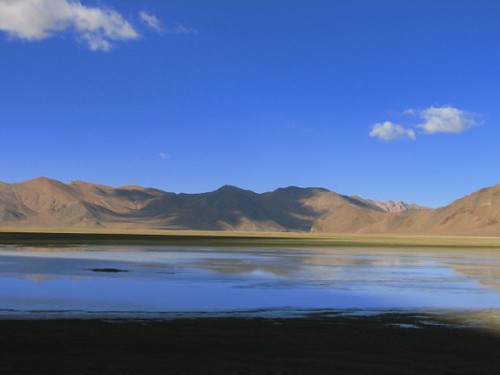 Morning vistas as we reached the TAR
Morning vistas as we reached the TAR
So, far out. We were in Ali! The longest single leg of the physical journey over just like that - rough and very smoky to be sure, but relatively plain sailing. All that remained to do was visit the PSB (Public Security Bureau). There we would turn ourselves in, say "yes sir, no sir, sorry sir", pay the approriate fine whilst looking appropriately sheepish and submissive and hey presto, a stamp and a signature or two and we would be 'legal' aliens, instead of illegal ones. It was a Sunday, but what the heck, we had a go.
At the PSB office and there was a door open so we wandered in to a large tiled ediface, curiously, cautiously. There was a caretaker woman there who told us to wait and made a phone call. A lovely Tibetan woman then rocked up, on her day off, and patiently put us through the rigours of Chinese PSB formality. She collected our fines, asked us some serious sounding questions - to which were warned to reply honestly - and then promptly issued us with red-ink stamped permits, all the while apologising to us for keeping us there! On her day off to be fair! Amazingly simple.
There was a hilarious sign in the hall of the PSB building, written in english apparently, quoting rules and regulations for would be 'legal aliens', but it was entirely indecipherable. I include a quote, word for word, to see if you can tell me what they are on about! I quote from the opening paragraphs of the sign, including typos: "The bust this that the public security gear adjust grasping ordinary visa foriegner and implements the visa administration chiefly to consist of the visa tosign and issue, defers and pluss autographs and alternation and withdrawing with proclaims is up to standard to be contain. Foriegner enters a country queen, in case the manouver which will be go in for outside original capacity have to propose the visa sort and alter the application to person in charges gear. In case man travelling together have to plus the bamboo slips." I'm sure they are trying to communicate something important - but what!?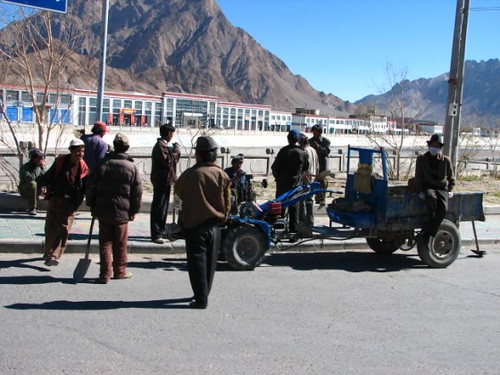 Tibetan road workers waiting for a lift in Ali
Tibetan road workers waiting for a lift in Ali
Ali was a kind of strange place. A far flung administrative outpost of a colonising power. My first impression when arriving at the town was of the ramshackle slums on its edges - housing Tibetans, not Chinese. The flavourless, stock-standard, white-tiled, two storey street frontage was full of mostly Chinese shops staffed by mostly Han Chinese. There were Tibetan shops to be sure, and Tibetan resturants full of Tibetans (and mostly horrible food), but they were in the minority. The most Tibetans i saw in this area were the roadworkers, grubby and darkened from their labour, either in road crews outside town or leaning on their shovels and waiting in gangs for lifts out to where the road crews were. I don't recall many Chinese wielding shovels. A two tiered society perhaps? Evidence to this effect beginning to accumulate.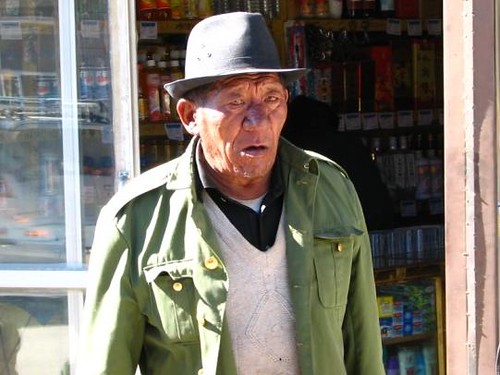 Elderly Tibetan man in Ali
Elderly Tibetan man in Ali
At last i was getting a chance to try out some rusty Tibetan, but i had learnt Lhasa dialect and this was far western Tibet, so there were some pronunciation difficulties to transcend! Without the two phrasebooks - Mandarin and Tibetan - we would have been stuffed for even the most basic tasks as very, very few people spoke even a word of english. Exasperatingly challenging communication difficulties aside, we managed to find out about public transport to Darchen - the town at the start of the Mt Kailash Kora.
However, we decided to do a several day detour along the way to a place which is renouned as one of the most spectacular examples of an old kingdom remaining in western Tibet - The Guge Citadel near Zhada, Tholing and Tsaparang, about 100 kms west of Mt Kailash in the depths of the Sutlej gorge. {I am aware that all these place names can easily become a blur of syllables, so have included a map below showing the rough location of Ali, the Guge Kingdom and Mt Kailash in relation to Kathmandu and Nepal.}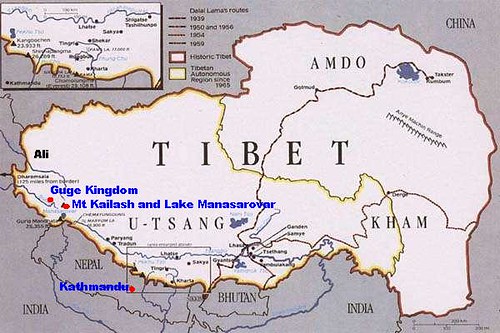 Rough location map of the Guge Kingdom and Mt Kailash in relation to Kathmandu and Nepal
Rough location map of the Guge Kingdom and Mt Kailash in relation to Kathmandu and Nepal
The journey to Guge was gob-smacking; vast plains and high passes surrounded by multi-coloured mountains - the result of massive iron-mineral deposits. The Chinese name for Tibet means "Western treasure house" - they are not likely to give up its resources so easily.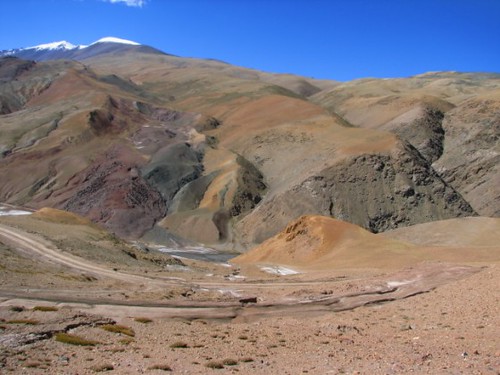 Iron-mineral laden mountains on the way to Guge Kingdom and Sutlej gorge
Iron-mineral laden mountains on the way to Guge Kingdom and Sutlej gorge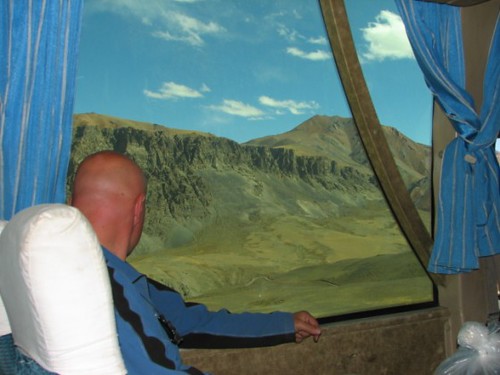 Mark on the bus, views on the road to Guge,....
Mark on the bus, views on the road to Guge,....
About 1/2 way into the trip the locals emptied out of the bus and it was just the four of us left, plus the drivers and about a dozen frazzled fish. Our slightly unusual travelling companions were bound for someones dinner at Zhada (the town near the Guge Kingdom) and were sloshing and joshing about with the bumps in a double layer of plastic bags. At one point some luggage fell down and knocked over one of the fish-bags on its side, smashing the styrofoam outer casing and abruptly changing the dimensions of the fishies world (I wonder what they were thinking?). I had this python-esque vision of the plastic bag rupturing and us bumbling buddhists struggling to catch slippery fish flapping around in the isle of a bouncing bus in the middle of a dry, rocky moonscape. Fortunately for the fishies, the bag held! Bagged fish on a bouncing bus
Bagged fish on a bouncing bus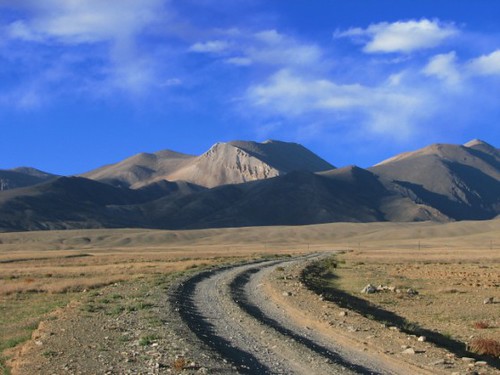 Afternoon light on the road to Guge
Afternoon light on the road to Guge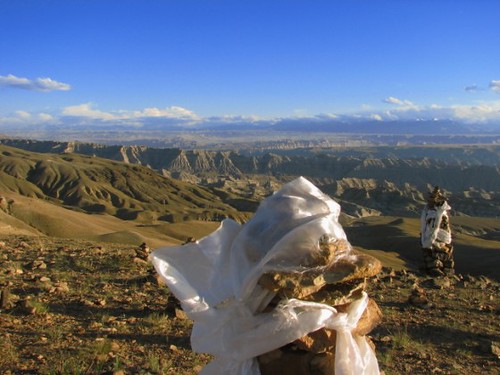 Kata and the Sutlej gorge in the background
Kata and the Sutlej gorge in the background
About 9 hrs later we rocked up at Zhada and found a pad for the night. The bus journey had been spectacular, but we were all buggered due to the kidney-bruising and eyeball-jarring roughness of the road. It made the road across the Aksai Chin seem smooth comparatively! Asking for the location of the loos (as you do when you rock up to a new place) we were informed that they were across the street; on the side of the main street in fact, just behind a couple of scraggly poplar trees with a fine view of passing pedestrians. Just dodge the remains of other peoples efforts and go for ya life. Lovely.
At this point i have to descend into a discussion about toilets, dunnies, the other end of the food tube etc - or the lack thereof - in western Tibet. No western Tibet related travel blogsite worth its salt could safely avoid this issue - unfortunate, but true. For those uninterested or squeamish, just skip this bit. You have been warned! I guess my first thought is "How hard is it to build a shitter??". I mean, you get a spade, dig a hole, bung some planks over it, raise a wall and a roof and hey presto. Apparently not. Most of the 'toilets' we encountered in western Tibet put Indian railway ones well to shame, and that is truly saying something. In fact they made most Indian ones i've seen look positively dazzling!
You could tell when you were approaching the 'toilet' by the increasing density of human droppings which radiate outwards from the central target, anything up to 20m or so. Apparently hitting the target (ie getting in the hole) is unnecessary, and anything in the approximate vicinity is good enough. Approaching the actual target is fraught with danger, both for your boots and nose, as the dropping density increases exponentially and one has to step very gingerly to find patches of safe earth. An absolute hoot in the dark!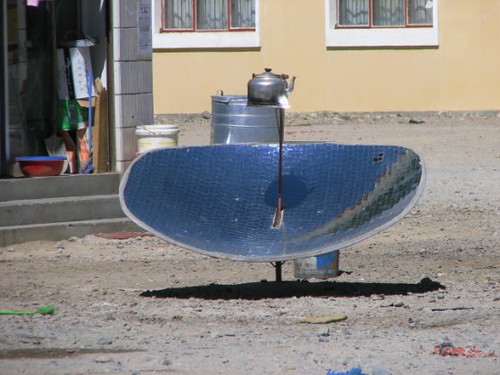 Not a dunny. Solar kettles were big throughout western Tibet, and good to see - renewable energy in action
Not a dunny. Solar kettles were big throughout western Tibet, and good to see - renewable energy in action
On to more savoury topics,....One of the main reasons for us choosing to visit the Guge kingdom was its historical significance for Tibetan Buddhism and contemporary links with our own lives. About 1000 yrs ago there was a very famous Indian Buddhist master, scholar and meditator called Atisha. Apparently he was invited to Tibet to teach, but initially declined. The King of Guge at the time who had invited Atisha, Yeshe-O, was captured by a foriegn power and held to ransom. When one of his relatives raised the approriate ransom sum in gold, Yeshe-O told him to use it to sponsor Atisha to come to Tibet instead and teach the Buddha Dharma, as this would be more beneficial than using the gold to save his life. So the story goes - it's a good story!
'Historically', Atisha did come to Tibet (spending many years there) and spent several years dwelling in the Guge kingdom at Tholing (right near modern day Zhada). It was here that he composed some pivotal texts, condensing the essence of Buddhist thoughts and philosphy for simple Tibetans. One such text was the Lam-Rim ('Lamp for the Path'). It was this architecture of Buddhist thought that Anna and i first encountered at Kopan Monastary in Nepal in 1996, subsequently transforming our lives. So, deep homage to King Yeshe-O and Atisha!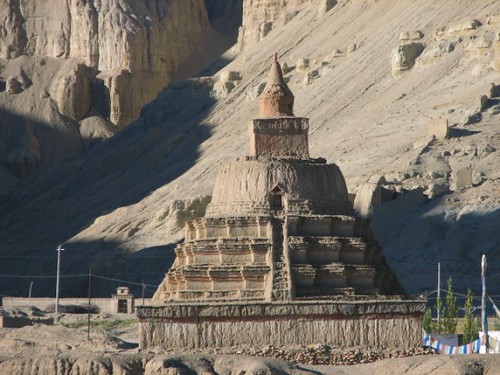 The stupa of King Yeshe-O at Zhada
The stupa of King Yeshe-O at Zhada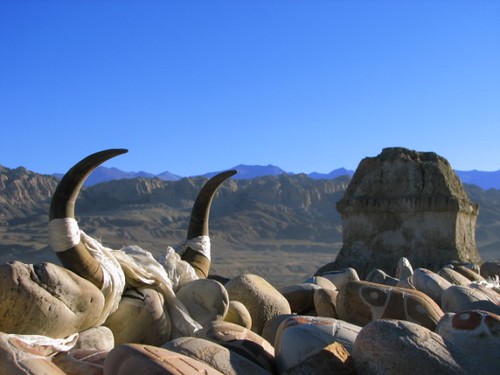 Stupas, mani stones and Yak horns at Zhada
Stupas, mani stones and Yak horns at Zhada
While the Lam-Rim was once composed just up on the hill behind the town, and once upon a time a large community of practioners dwelt here, Zhada now is a far cry from its high history. Impermanence. Now a one-street Chinese town, complete with knock-shops and Karaoke bar. The stupa at the end of town near the Sutlej River had been restored and Tibetans allowed to circambulate and say mantras again, but the prayer wheels had no mantras on them. Just yellow, rotating tin cans. Kind of symbolic for the hollowness and facade of what i saw later on in the journey at Tashilhunpo Monastary in Shigatse.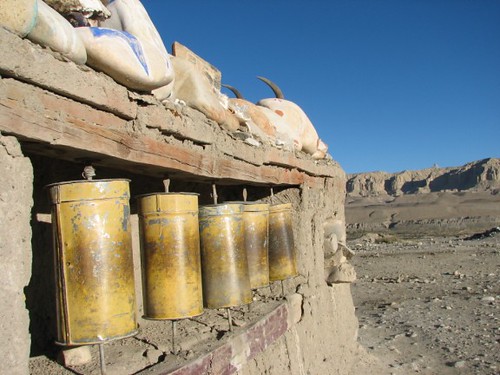 Rotating tin-cans - prayer wheels without mantras
Rotating tin-cans - prayer wheels without mantras
One afternoon i climbed up amoung the ruins of the old city above Zhada, hunting for some atmosphere and sense of what this place must have been like - an age ago. Ruined forts, old caves and broken stupas greeted me, a biting wind rushing up the Sutlej valley as the sun set. I came across a large stupa which had been broken into, guardian boddhisattva snow lions violated - maybe someone vainly hoping for material riches on the inside? Curiosity overcame me and i poked my head in the dark to have a look; disorded and decaying pages of pechas and many beautiful little tsa-tsas lay scattered among the dark rubble. Relics of a time now gone,....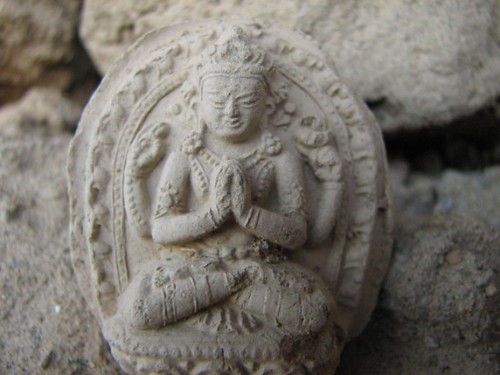 Chenrezig tsa-tsa from the insides of a broken stupa
Chenrezig tsa-tsa from the insides of a broken stupa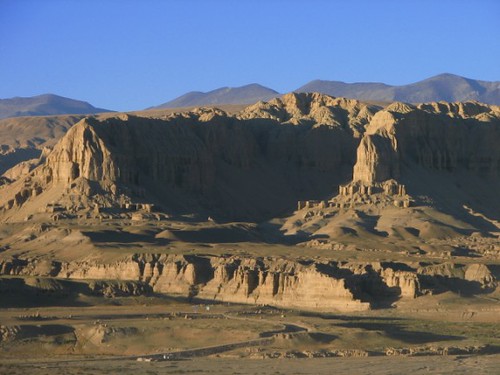 Hillside view and afternoon light from ruined city above Zhada
Hillside view and afternoon light from ruined city above Zhada
The Guge Citadel ruins were incredible. A joint testimony to lost kingdoms, tantric buddhism, communist notions of 'creativity' and burrowing all at once. Must have been astounding in its hey-day. An ants-nest and rabbit warren of tunnels, Gompas, dwellings, caves, stairs and secret passageways all winding, twisting and bending their way into a roughly conical shaped hillside made of soft mudstone.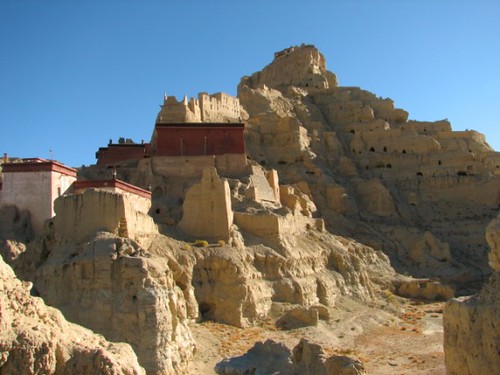 Guge kingdom citadel
Guge kingdom citadel
After arriving we were escorted (minded is more like it) through a series of Gompas. These originally contained some of the most significant statues and Buddhist wall frescoes in western Tibet. Now they were all under lock and key and you were definitely not allowed to take photos inside (so the ones you see here were taken very discretely and from the rooftop skylights). After entering it seemed clear why. All had been heavily desecreated by the Red-guards during the height of the Cultural Revolution. Broken statues with limbs torn off spewing contents all over the floor; shattered buddha heads, holes in the walls and torn scriptures were most of what remained, apart from the atmosphere and some remnant wall art hidden in the gloom.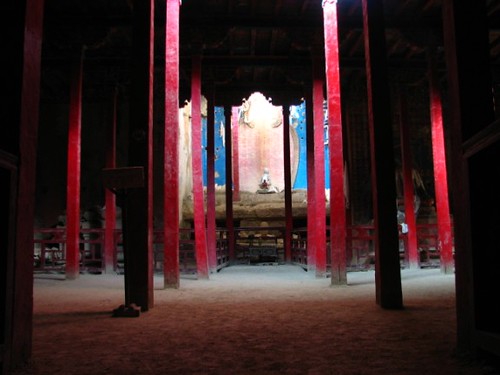 Remnants of a red guard rampage. Empty gompa, golden Buddha gone, light remains,...
Remnants of a red guard rampage. Empty gompa, golden Buddha gone, light remains,... 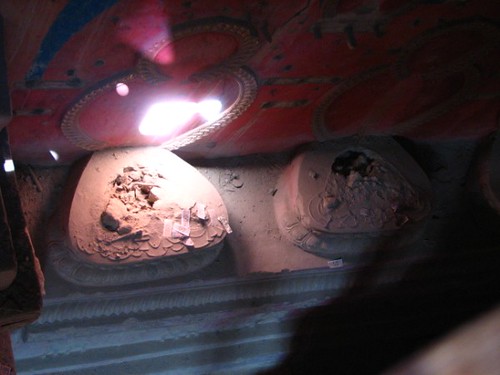 Smashed statues and a shaft of light in a ransacked gompa
Smashed statues and a shaft of light in a ransacked gompa 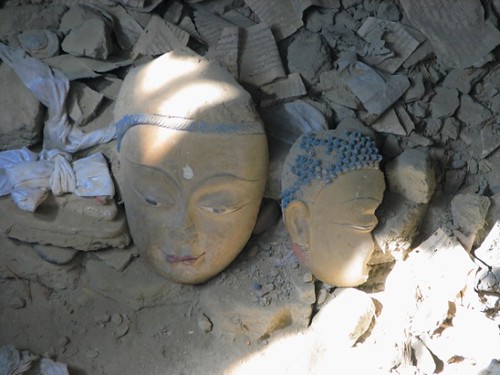 Buddha faces and piles of pecha (Tibetan scriptures) in the rubble
Buddha faces and piles of pecha (Tibetan scriptures) in the rubble
Obviously the Red Guards had taken their job seriously. I tried to put myself in their shoes - What were they thinking at the time? This place is insanely remote, 1000's of km from Beijing, hard enough to get to now and it must have been incredibly difficult back then when there were no roads. What kind of thought process had to lie behind the zeal and single-minded intensity required for someone to travel over such austere distances to engage in acts of petty vandalism and bust up a few statues and Buddha heads?? Obviously for them it wasn't petty vandalism and they believed in what they were doing, otherwise they could not have made the effort. Unfathomable.
The official Chinese blurb that greets tourists at the front gate mentions nothing of this, just an obscure reference to the Kingdom having fell into ruins after wars in the 17th century. The history written by the victors is so often one-sided that it does little to promote reflection by subsequent generations. How much white-washing like this throughout the ages? I think of my own experience growing up in Australia and what i was not told or taught about the genocide of Aboriginals. The horror of what was left out. Just one-dimensional tales of glorious white explorers who 'conquered' a vast, unexplored new land. Are there any places or people on Earth to whom this has not happened to?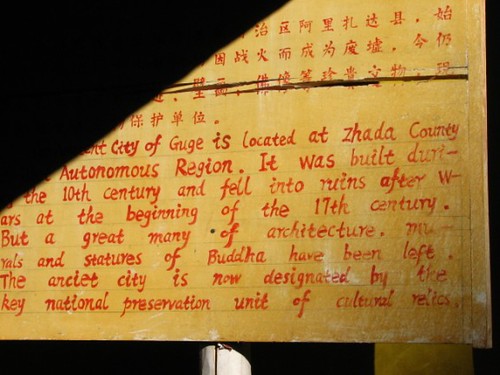 Official Chinese bullshit sign no. 1 of many
Official Chinese bullshit sign no. 1 of many
To be fair, some of the remaining wall art was pretty amazing. Incredible detail and covering every surface of some Gompas in a riot of colour, dieties and pictorial stories. Such a potent and vivid contrast with the rough world of brown rock and endless blue sky outside. The contrast causes them to impress upon the mind. I found myself having visual flashbacks of stupas, multi-armed dieties and colourful mandalas as i was preparing for sleep that night. As we left the Gompas and wandered up into the complex itself, we came across some meditation caves that had a black encrustation on the walls and roof that resembled tar - accumulation and congealed smoke of how many millions of butter lamps past? How many offering prayers?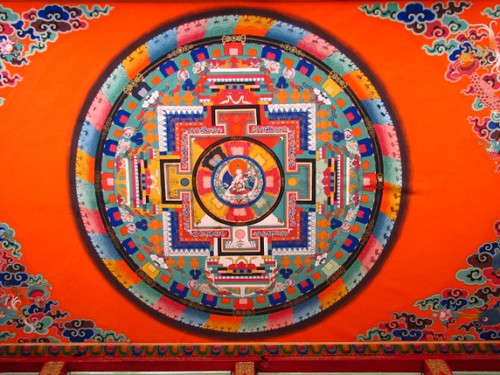 Mandala at Darchen Gompa. Similar, much older mandalas remained in the Gompas at Guge, but could not be photographed
Mandala at Darchen Gompa. Similar, much older mandalas remained in the Gompas at Guge, but could not be photographed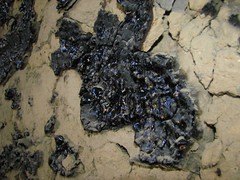 Butter lamp tar on the walls. How many years of burning butter?,....
Butter lamp tar on the walls. How many years of burning butter?,....
The rest of the complex was great to wander about in, and would have been a hoot if you were a kid with a tribe of friends playing hide and seek! Views from the summit over the Sutlej gorge and surrounding valleys were nuts. But i'll shut my mouth now and let some of the photos do the talking for me,.....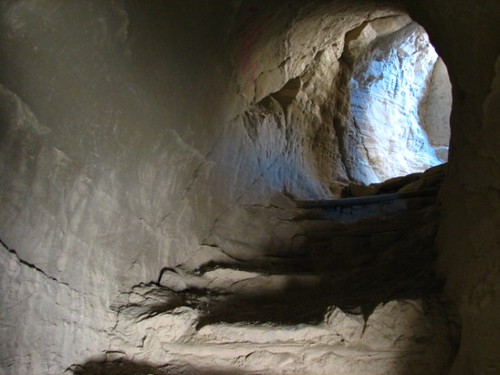 Tunnels carved out of the mudstone winding through the citidel
Tunnels carved out of the mudstone winding through the citidel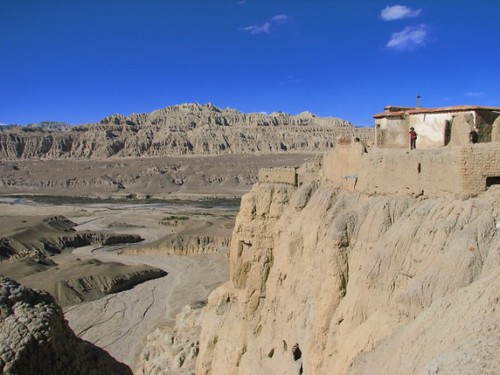 North views from the summit of the Guge citadel
North views from the summit of the Guge citadel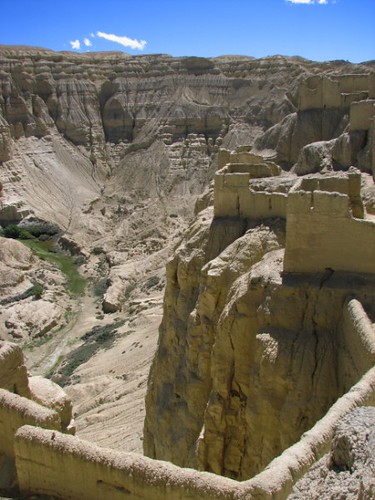 South views from the summit of the Guge citadel
South views from the summit of the Guge citadel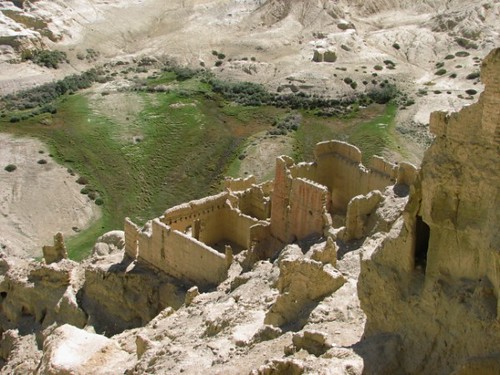 View of the valley below the Guge ruins
View of the valley below the Guge ruins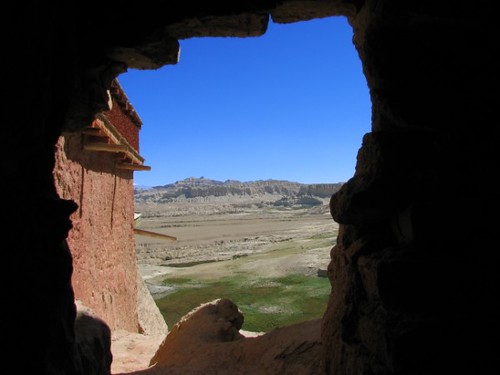 Decaying walls and a view to a Gompa and valley below
Decaying walls and a view to a Gompa and valley below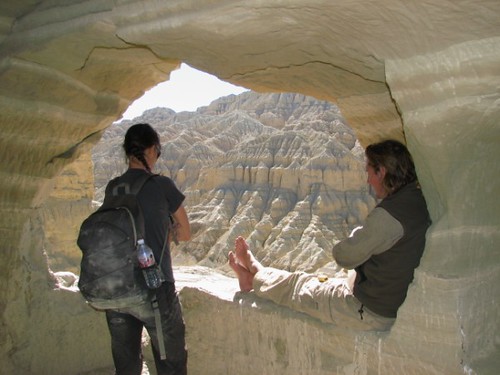 Anna and Joe contemplating the view from a window of the winter palace at Guge
Anna and Joe contemplating the view from a window of the winter palace at Guge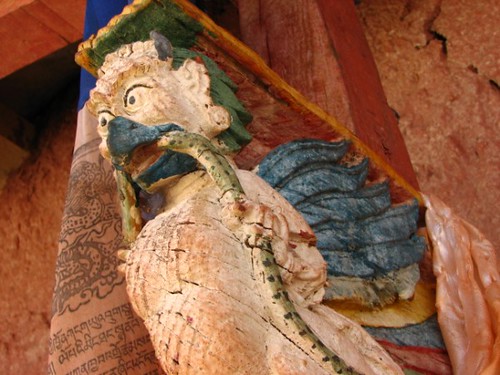 Temple roof detail at Guge - a Garuda of wisdom eating a snake of ignorance
Temple roof detail at Guge - a Garuda of wisdom eating a snake of ignorance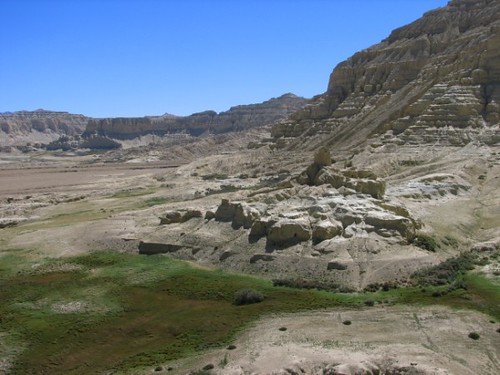 Guge fort and surrounding hills
Guge fort and surrounding hills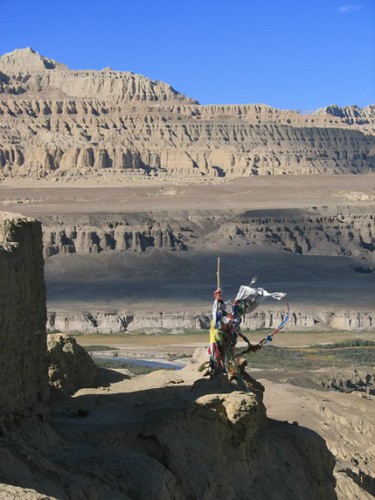 Prayer flags and the Sutlej gorge at Guge
Prayer flags and the Sutlej gorge at Guge
I think it was in Zhada that it became very apparent that we were minority travellers. (It also became apparent that all of us were suffering from outrageous foot odour! - Chinese food (?) or too long in boots (?), who's to know!). There were stacks of other injies there to visit Guge, mostly middle-aged Europeans, but they all had very expensive private hire-jeeps and guides and the majority had come in from Lhasa. We weren't real thrilled about the prospect of getting back on the bone-bruising bus out of there with our not-so-friendly chain-smoking drivers, but few other options existed. So we got back on the public bus, out of the Sutlej gorge over the passes and out to the main road where we intended to hitch a lift to Darchen.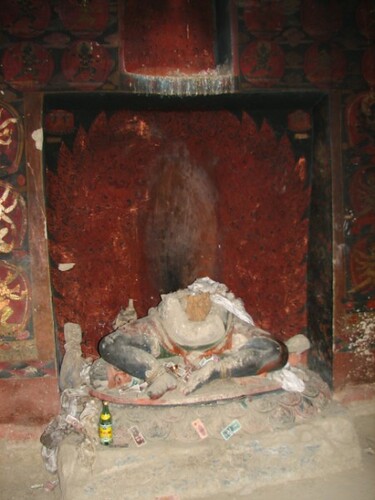 Broken statue in a wrathful deity room at Guge
Broken statue in a wrathful deity room at Guge
This trip was intense and a bit of an emotional crossing point for me in terms of my patience with 'Chinese' behaviour and their way of relating to us - like barbarians with wallets - whatever trickle of patience that had been there dried out. The bus was loaded with chain-smoking Chinese, spagging on the floor and barking at each-other and us. Part of me doesn't want to even speak about them like this now or give energy to an aggressive, deluded and shallow view of them and their behaviour - yet that was definitely my view at the time. I was off it! They really couldn't understand our smoked-induced suffocation and desire to let fresh air in the windows, leading to some mutual tension during the journey. The bus driver even stopped the bus at one point and was going to evict Joe who was resisting paying the rip-off fee we had been charged. However, we made it to the main road and happily leapt off the bus, into the waiting arms of a bunch of Swiss travellers who had their own vehicles and were heading to Darchen! Their guide was a lovely Tibetan guy who called himself 'Everest' and we managed to sqeeze into a 4WD with him and a driver the following day, anticipating our first views of Kailash. Swiss lift no. 2
Swiss lift no. 2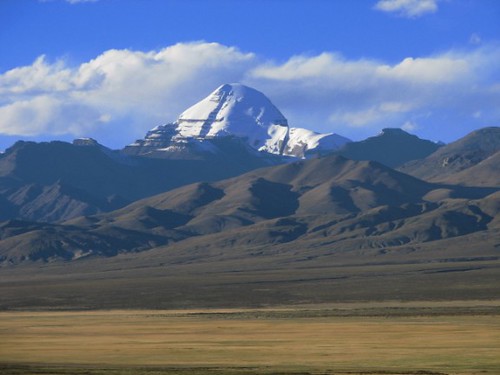 Mt Kailash beckoning,.....
Mt Kailash beckoning,.....
Rounding hills and crossing streams, past masses of roadworks, excitment mounting, "Is that it?", "Surely its that one?". We saw the looming southern face in the distance and glimpsed the steep sides of the western valley where the Kora trail goes as we approached Darchen. We paid a quick visit to the Darchen Gompa, loaded up on some tucker, recharged batteries and then got ourselves a hire-jeep for the 40km trip to Lake Manasarovar - on a mission to get married!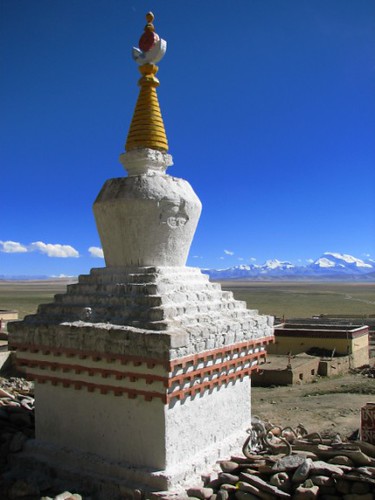 Stupa at Darchen
Stupa at Darchen
One wedding, several Koras and a very long way,......continued
Skip to Part 2
Skip to Part 3
Skip to Part 4



